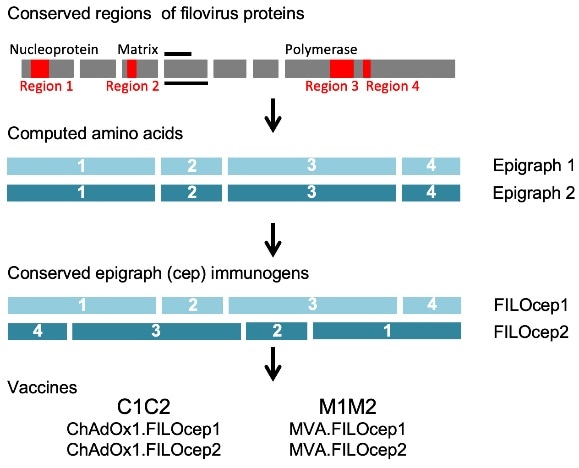Mar 4 2019
Vaccines that induce protective T-cell responses could protect against members across the filovirus family, according to a study published February 28 in the open-access journal PLOS Pathogens by Tomáš Hanke of the University of Oxford, Bette Korber of the Los Alamos National Laboratory, and colleagues.

Conserved regions of the filovirus proteome (red) are the most similar parts of proteins common across the eight virus species of the filovirus family. These regions were identified by amino acid alignment of all known filovirus isolates in the database. An algorithm called Epigraph computed bi-valent amino acid sequences (epigraph 1 and epigraph 2), which complement each other and are used together in a vaccine to optimize match of potential T-cell epitopes between the vaccine and all input filovirus species. For the FILOcep1 and FILOcep2 epigraphs, the four regions 1, 2, 3 and 4 are 280 (nucleoprotein 131–410), 123 (matrix 71–193), 315 (RNA polymerase 540–854) and 109 (RNA polymerase 952–1060) amino acid long, respectively, and were arranged into different orders to minimize potential induction of T cells recognizing irrelevant (non-viral) newly generated epitopes across the regional junctions. Synthetic ORF coding for these two proteins each 827 amino acid in length were inserted into engineered replication-deficient simian (chimpanzee) adenovirus ChAdOx1 and replication-deficient poxvirus MVA to generate four components of the vaccine abbreviated C1, C2, M1 and M2. Credit: Credit: Rahim et al. (2019)
Developing an effective vaccine against filovirus outbreaks is an important public health aim. Vaccine candidates being developed for a small number of filoviruses that most commonly cause outbreaks all employ the virus glycoprotein as the vaccine immunogen, which triggers a protective immune response. However, antibodies induced by such glycoprotein vaccines are typically limited to the other members of the same filovirus species. By contrast, T-cell vaccines offer the possibility to design a single pan-filovirus vaccine that protects against all known and even likely existing, but as yet un-encountered, members of the filovirus family. In the new study, Hanke and colleagues constructed vaccines using cross-filovirus immunogens – conserved regions of filovirus proteins -- with the aim of inducing protective T-cell responses against viruses across the filovirus family.
The authors demonstrated that T-cell responses can protect two strains of mice against a high lethal virus challenge in the absence of glycoprotein antibodies. Moreover, a single T–cell vaccine can do so against distant members of the filovirus family: Ebola and Marburg viruses. This suggests the possibility that this candidate vaccine also protects against other known, as well as yet un-encountered, viruses of the filovirus family. According to the authors, a successful pan-filovirus vaccine would have multiple uses, such as generating vaccine stockpiles to contain future outbreaks, eliminating the 2013 and 2018 outbreak remnants, eliminating virus reservoirs in survivors, providing long-term protection in high-risk populations including health workers, and even saving highly endangered western gorillas.
A universal pan-filovirus vaccine might be possible, which induces killer T cells against the most conserved regions of the inner filovirus proteins very similar among all the member viruses from Ebola to Marburg. Such T-cell vaccine can complement any existing vaccines inducing antibodies against the surface glycoprotein.”
Tomáš Hanke, University of Oxford